If you have a passing interest in history (either medieval or modern), great food and drink, pretty French villages and towns, or picturesque coastlines, you’ll find many worthwhile places to visit in Normandy. It’s suitable for Paris day-trippers, camping holidays with the kids, and romantic city breaks alike, but with so many charming towns to check out, including Bayeux (the tapestry!); Rouen (impressive Gothic architecture); Honfleur (artistic and charming harbour town); and Mont Saint-Michel (the iconic UNESCO site), deciding where to visit and what to do can get a little overwhelming without someone (aka me) to condense things a little.
This travel guide is therefore designed to give you a better idea of where to visit in Normandy, depending on your specific interests. BTW, Biffers Gourmands like me should also keep in mind that Normandy is a foodie’s paradise, famous for its Calvados apple brandy, gorgeous sparkling cider, and indulgently creamy Camembert cheese to name just a few.
So, with all that said, I’ll give you my recommendations on which towns to visit, where to stay, and what to do there. So, don’t be like King Harold and wait for the Normans to come to you, read on and get planning your own Normandy invasion!
Ferries from the UK
There are four different ferry routes to Normandy from England. These are operated by either Brittany Ferries, DFDS, or Condor. Cherbourg or Caen ferries are the closest ports to the Normandy D-day landing beaches, and the Le Havre ferry from Portsmouth is also relatively close. Full details of all the Normandy ferries and who operates them are below. When it comes to booking your ferry tickets, it’s usually better to book direct with the operating company, although it may also be worth using a ferry aggregator like Direct Ferries to compare and double check prices, as sometimes you can find some cracking deals on there. Check out my post for full details of all UK to France ferry crossings.
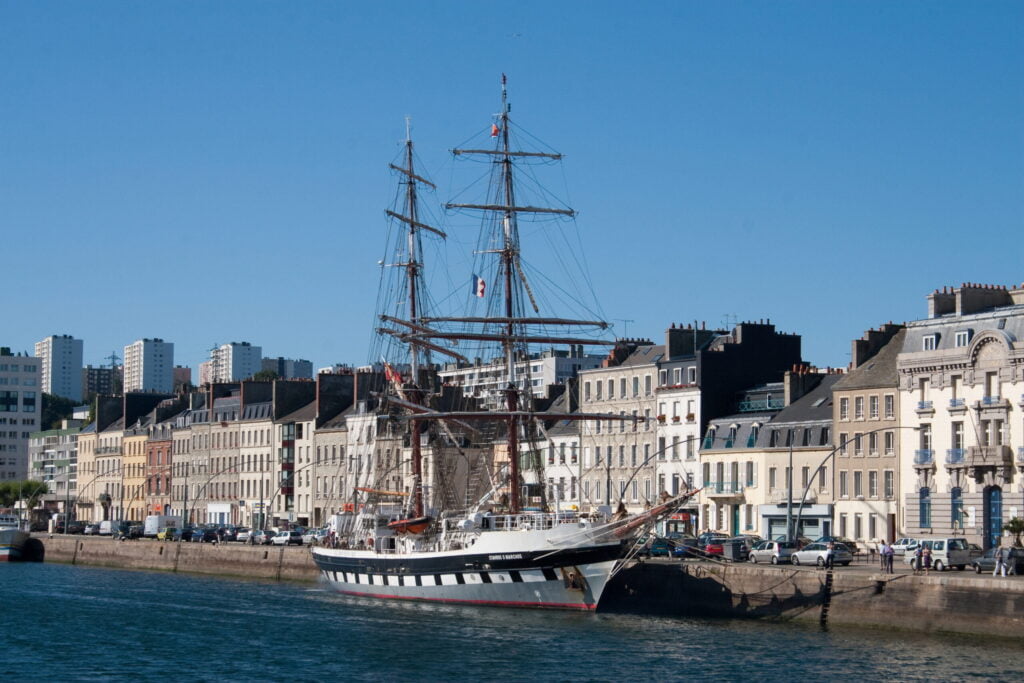
Cherbourg ferry port is served by Condor Ferries from Poole, and Brittany Ferries from Portsmouth and Poole.
Caen ferries arrive from Portsmouth and the route is served by Brittany Ferries. Note that Caen ferry port is actually located 15 km north of Caen city center, in Ouistreham.
The Le Havre ferry arrives from Portsmouth and is also operated by Brittany Ferries
Newhaven to Dieppe ferries are operated by DFDS.
Trains from Paris
France has an excellent high speed rail network, which makes getting around this relatively vast European country a breeze. Being just a couple of hours north of Paris means that Normandy becomes easily accessible for day trips from the capital too. You can take direct trains from Paris to Caen (1 hr 50 mins), Bayeux (2 hrs 10 mins), Rouen (around 1hr 20 mins), Le Havre (around 2 hrs 15 mins), and Cherbourg (a little over 3 hrs). All of these trains from Paris to Normandy are significantly faster than driving. Check out either Omio or the Trainline for full schedules, prices and tickets.
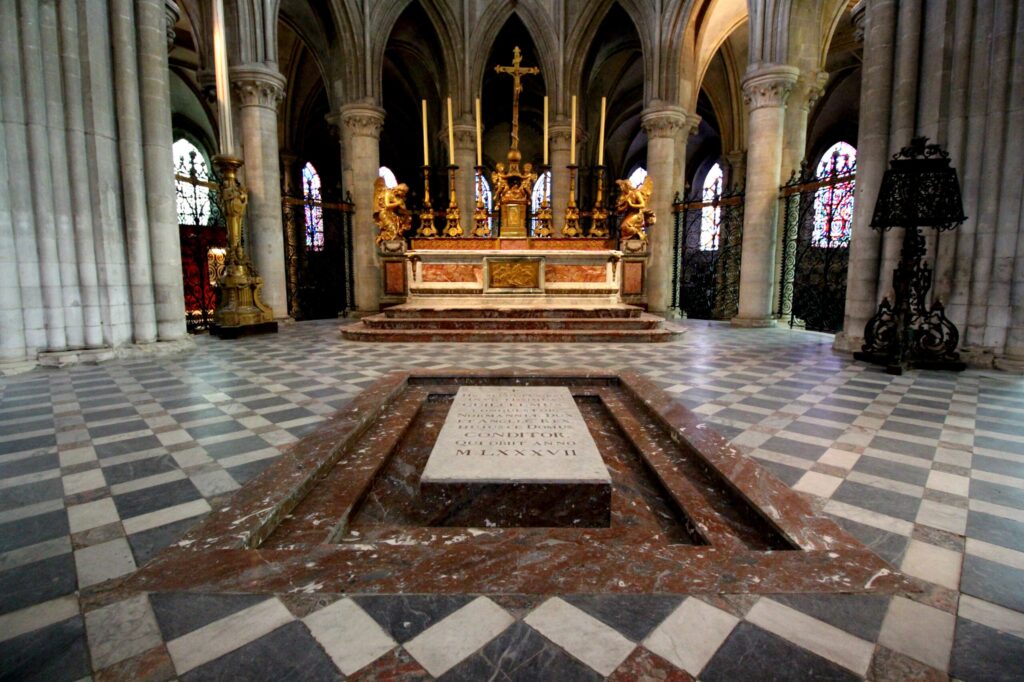
Places to Visit in Normandy
With so many picturesque towns, cities and hamlets to choose from, deciding where to base yourself in Normandy (and where to ‘just’ visit) isn’t that easy, so here’s a guide to each destination and their highlights…
Honfleur: A picturesque harbour town with artistic heritage and scenic views
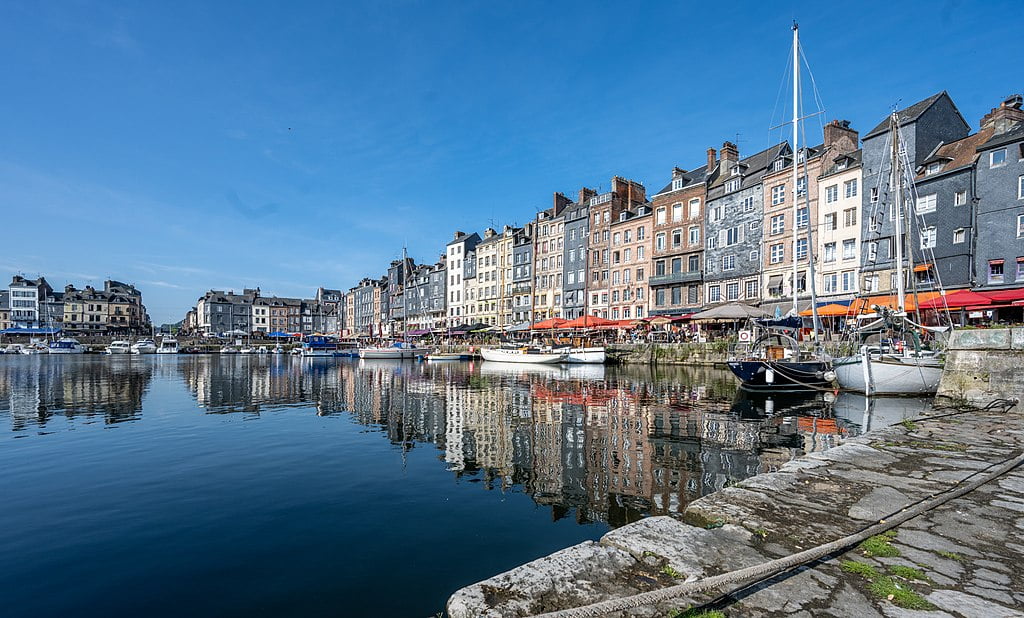
Honfleur is a charming harbor town in Normandy known for its picturesque old port, narrow cobblestone streets, and distinctive half-timbered houses. At the heart of Honfleur is the Vieux Bassin, or old port, where colorful buildings line the waterfront—scenes that have inspired renowned artists like Claude Monet and Eugène Boudin. Today, Honfleur’s vibrant arts scene continues to flourish, with galleries, cafes, and a relaxed ambiance that make it a favorite for visitors.
In addition to its artistic legacy, Honfleur boasts remarkable architecture, including the Church of Saint Catherine, the largest wooden church in France, built in the late 15th century. Located where the River Seine meets the English Channel, Honfleur is also a convenient stop for those arriving by ferry, just a 30-minute drive from the Le Havre ferry port.
Things to do in Le Havre and Honfleur
- Visit the Vieux Bassin: The old port is Honfleur’s main attraction, surrounded by colorful buildings that reflect in the water—a perfect spot for photography and leisurely strolls.
- Explore Honfleur’s Art Scene: Discover galleries inspired by Impressionist painters, and visit art studios showcasing local talent.
- Learn all about how Calvados (Apple Brandy) is made, enjoy a tasting and understand why it is so important to the region as a whole at the Calvados experience
- Enjoy Fresh Seafood: Honfleur is known for its seafood, so don’t miss out on trying local dishes at the portside cafes and restaurants.
- Honfleur is a good base for day trips to the cliffs of Étretat, known for their dramatic beauty on the Norman coastline between Le Havre and Dieppe.
- From Honfleur: take a Private sidecar tour and cider tasting. Continuing with the apple theme, Normandy makes some of the world’s best cider, so what better way to go try some while being driven about like Wallace and Grommet in a cool vintage sidecar! Added bonus – you don’t even have to drive!
- See the Church of Saint Catherine: This unique wooden church, dating back to the 15th century, is a must-see for its impressive design and historic significance.
Tip: If arriving by ferry, Honfleur is an easy 30-minute drive from the Le Havre ferry port, making it an ideal first (or last) stop on a Normandy adventure.
Where to stay in Honfleur
Quite simply, the highest rated hotel on pretty much every hotel booking platform out there, the extravagantly named Hotel Saint-Delis – La Maison du Peintre, translates to ‘Painter’s House’, as it used to be home to artist Henri St Delis. Located in the heart of Honfleur’s historic district, the rest of the town is easily walkable from this lovely boutique hotel. Only has 9 rooms though, so do be quick!
La Maison de Lucie is a refined, classy little hotel, with guest parking, and wonderfully attentive staff who always do their utmost to make guests feel special. Be sure to check out its beautiful courtyard for breakfast and evening aperitifs!
La Ferme Saint Simeon is a spectacular 5 star hotel set in immaculate gardens, and overlooking the Seine River estuary. Two on-site restaurants, extremely welcoming staff, and its picture postcard location makes this one of Honfleur’s most sought after places to stay.
Bayeux: the tapestry, medieval festivals, & D-Day beaches
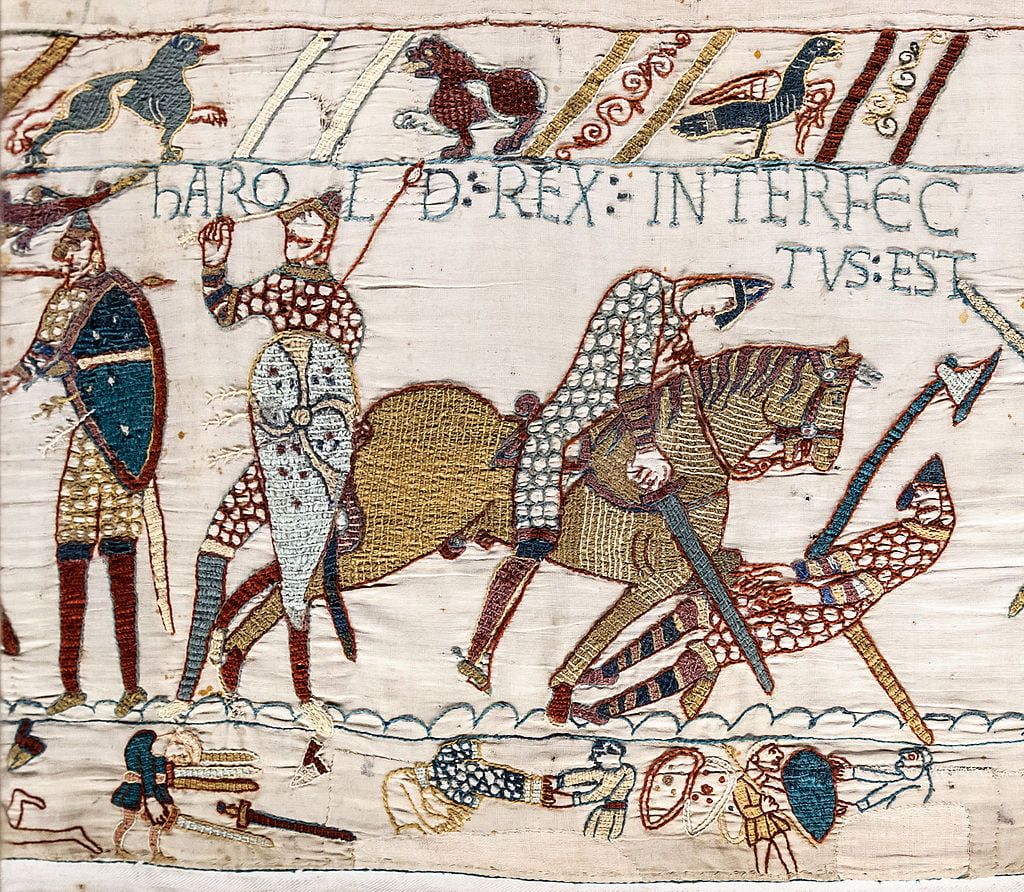
One of the oldest towns in Normandy, Bayeux is rich with Norman history and medieval charm. Each year, the Bayeux Medieval Festival brings the town’s heritage to life with re-enactments, concerts, and bustling craft markets, celebrating the legacy of this ancient town. Bayeux’s most famous attraction is the UNESCO-listed Bayeux Tapestry (Tapisserie de Bayeux), a 70-meter-long embroidered masterpiece depicting the Norman conquest of England, culminating in the 1066 Battle of Hastings. This remarkable artifact is displayed at the Musée de la Tapisserie de Bayeux, a must-see for history enthusiasts.
Another highlight is the Bayeux Cathedral (Cathédrale Notre-Dame de Bayeux), an 11th-century architectural marvel blending Romanesque and Gothic styles. The town itself offers a beautifully preserved historic center with narrow cobblestone streets, half-timbered houses, and quaint squares that transport visitors back in time.
Things to do in Bayeux and Caen
- Visit the Bayeux Tapestry: Marvel at this world-renowned, 70-meter-long tapestry illustrating the story of the Norman conquest of England, housed in the Musée de la Tapisserie de Bayeux.
- See the burial place of William the Conqueror in the Abbaye aux Hommes.
- Take a food tour of Normandy sampling cider, Camembert, Calvados and food at a 2* Michellin starred restaurant.
- Visit the Caen Memorial Museum
- Visit the Memorial Museum of the Battle of Normandy which recounts events from the battle which raged from D-day until the end of August, 1944.
- Explore Bayeux Cathedral: The stunning Bayeux Cathedral, an 11th-century masterpiece, combines Romanesque and Gothic elements and is central to the town’s history.
- Attend the Bayeux Medieval Festival: Each summer, this lively festival celebrates Bayeux’s medieval heritage with re-enactments, music, and artisanal crafts.
- Wander the Historic Town Center: Stroll through Bayeux’s charming old town, filled with timber-framed houses, cobblestone streets, and picturesque squares.
Tip: Bayeux as a base for D-Day exploration. Bayeux is a perfect base for exploring the famous D-Day landing beaches, including Omaha Beach and Gold Beach, which are just a short drive away.
Where to stay in Bayeaux
Hotel Villa Lara is a 5-star luxury boutique hotel situated in the historic center of Bayeux, France, directly facing the 11th-century cathedral and just a two-minute walk from the renowned Bayeux Tapestry. Established in 2012, the hotel offers 28 elegantly appointed rooms featuring period-style furniture, flat-screen TVs, minibars, and marble bathrooms. In 2019, the adjacent Villa Augustine was introduced, adding four presidential suites within a charming 19th-century building. Guests can enjoy a daily buffet breakfast, a cozy bar/lounge area with a fireplace and library, and a 24/7 fitness center. The hotel’s prime location provides easy access to local attractions, including the D-Day landing beaches.
Clos de Bellefontaine is a charming 19th-century bed and breakfast located in the historic center of Bayeux, France. Situated within a 10-minute walk from the Bayeux Tapestry Museum and the cathedral, it offers guests convenient access to the town’s main attractions. The B&B features elegantly furnished rooms with private bathrooms, overlooking a tranquil enclosed garden. Guests can enjoy a daily homemade breakfast in the dining room or on the south-facing terrace. The property provides amenities such as free Wi-Fi, secure parking, and a spacious lounge area. Hosts Carole and Jérôme are known for their warm hospitality and personalized service, ensuring a memorable stay for their guests.
Hôtel Particulier “Le Clos de la Croix” is an 18th-century mansion located in the heart of Bayeux, France. The property features five charming guest rooms that blend antique elements with modern comforts. Original features such as stone staircases, parquet floors, and marble fireplaces have been preserved, offering guests an authentic historical ambiance. Surrounded by a tranquil park with century-old trees, the mansion provides a peaceful retreat within the city. Guests can enjoy a refined continental breakfast each morning. The central location offers easy access to Bayeux’s attractions, including museums, shops, and restaurants.
Mont Saint-Michel
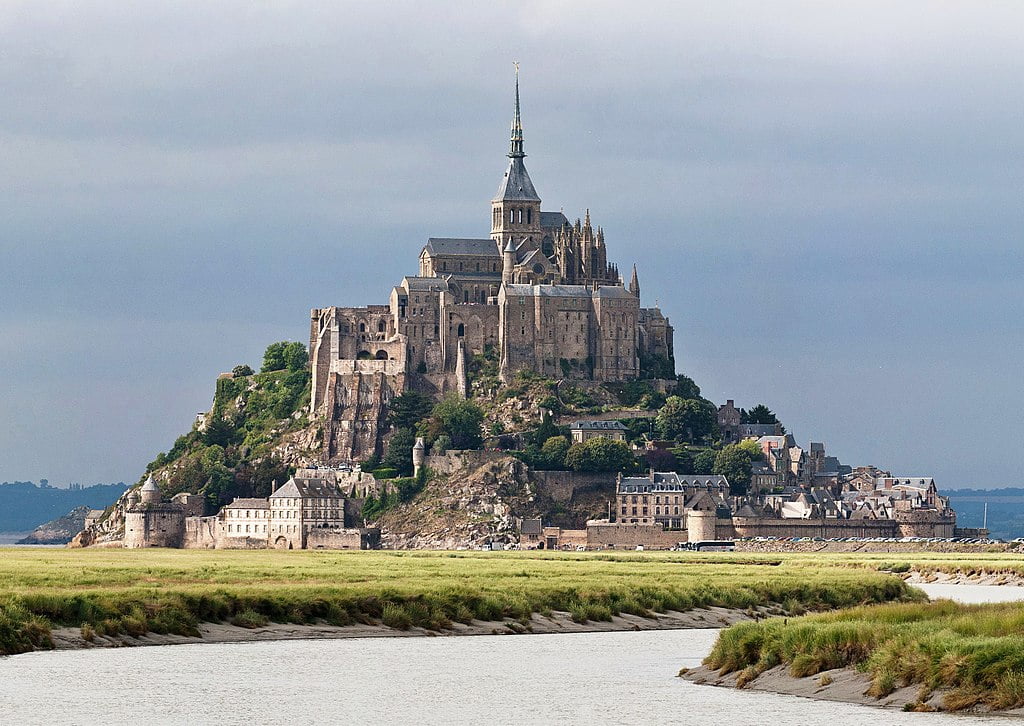
Mont Saint-Michel is a breathtaking island commune located in western Normandy, France. Its most iconic feature is the stunning 8th century abbey that crowns the island’s rocky peak. It attracts millions of visitors each year, and its construction spanned several centuries, resulting in a blend of architectural styles, from Romanesque to Gothic. One of the most unique aspects of Mont Saint-Michel is its tidal nature. During high tide, the island is surrounded by water, and during low tide it becomes accessible on foot to visitors via a causeway. Aside from the abbey, the narrow cobblestone streets winding through the village below are filled with charming shops, restaurants, and houses.
Things to do in Mont Saint Michel & Cherbourg
- Cité de la Mer: (the City of the Sea) is a maritime museum housed in a former transatlantic ocean liner terminal. Expect submarine exhibits, Titanic artifacts, and a massive aquarium. Jacques Cousteau & Steve Zissou fans rejoice – this one’s for you.
- Visit the abbey of Mont Saint Michel for spectacular views and the full experience of this remarkable place. I’ve been there several times, and it never gets old. Even if you’re not that bothered about the history, the natural beauty of its location is impressive and just wandering around this absolutely unique island is very cool.
Rouen: History, Architecture, and Culture on the Banks of the Seine
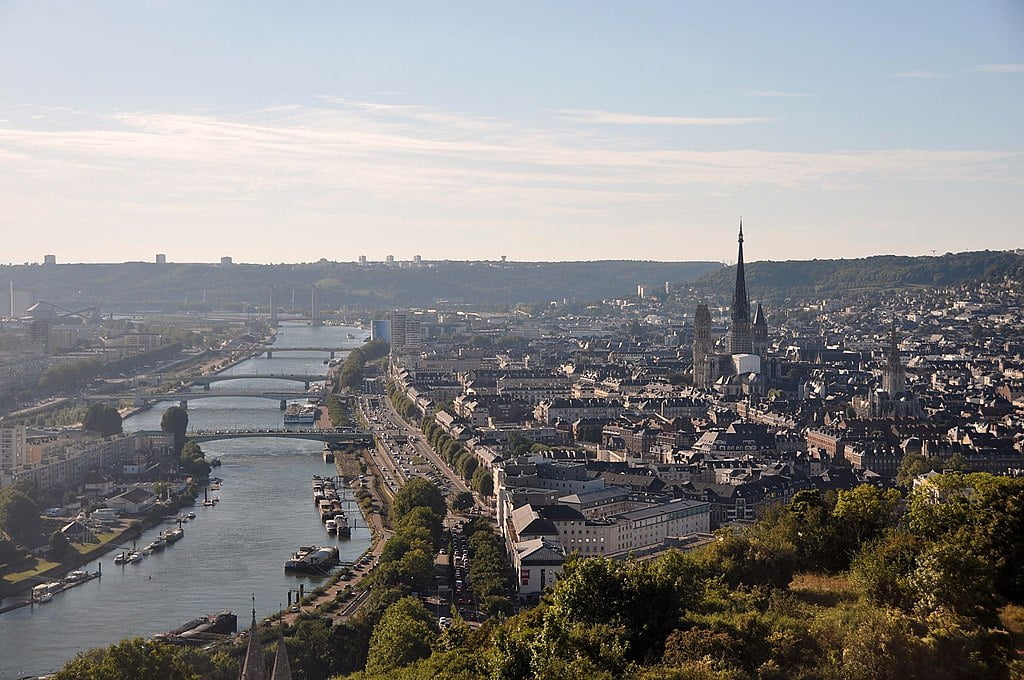
Nestled along the banks of the Seine, Rouen is a historic city in Normandy best known as the site where Joan of Arc was famously tried and executed in 1431. The city’s impressive Gothic architecture is highlighted by the Rouen Cathedral (Cathédrale Notre-Dame de Rouen), whose intricate stone carvings and beautiful stained-glass windows were famously painted by Claude Monet. As you wander through Rouen’s old town, you’ll encounter narrow cobblestone streets, charming half-timbered houses, and landmarks like the Gros-Horloge, a stunning astronomical clock dating back to the 14th century.
For food lovers, Rouen offers a taste of traditional Norman cuisine, with specialties such as duck confit, creamy local cheeses, and apple-based desserts like tarte aux pommes. Rouen’s cultural scene is equally vibrant, hosting festivals throughout the year that celebrate its rich heritage. The most famous event is the Armada de Rouen, a maritime festival where a parade of tall ships lines the Seine, drawing visitors from across the world.
Things to do in Rouen
- Take a walking tour of Rouen to see all the city’s main highlights, including Rouen Cathedral, the Gros-Horloge and the medieval quarter, Martainville.
- For art lovers, check out the Musée des Beaux-Arts de Rouen, which houses a big collection of paintings and sculptures.
- Visit the unique and innovative Joan of Arc Historial – and interactive museum which brings the building that houses it to life, and takes you right to the heart of the life and legacy of the French heroine.
Tip: To see Rouen at its most lively, consider visiting during the Armada de Rouen festival in June, when the city’s waterfront transforms into a celebration of maritime history.
Smaller villages and hamlets in Normandy worth visiting
While Normandy is famous for its larger cities like Rouen and Bayeux, the region’s true charm often lies in its smaller towns. These quaint villages offer visitors a glimpse into traditional Norman life, with half-timbered houses, cobblestone streets, and rich local culture. Here are some of the most charming small towns in Normandy, each with its own unique character and attractions.
1. Beuvron-en-Auge
One of the most picturesque villages in Normandy, Beuvron-en-Auge is set in the heart of the Pays d’Auge region, famous for its cider and cheese. Wander its flower-filled streets and admire half-timbered houses dating back to the 17th century. Don’t miss the town’s craft shops, cafes, and local markets selling Calvados and Camembert.
2. Étretat
Known for its stunning cliffs and natural arches, Étretat is a coastal gem that has inspired artists like Claude Monet. Hike the trails along the cliffs for breathtaking views of the English Channel, or explore the town’s quaint streets, filled with artisan shops and cafes.
3. Barfleur
A small fishing village with a rich maritime history, Barfleur’s charm lies in its granite houses, picturesque harbor, and slow pace of life. Famous for its mussels, Barfleur is the perfect spot for seafood lovers looking to enjoy the day in an authentic Norman village.
4. Cambremer
Located along the Cider Route, Cambremer is a charming village surrounded by apple orchards and rolling hills. Visit the Église Saint-Denis, a beautiful church, and stop by a local distillery to sample Calvados. This town is ideal for experiencing Normandy’s rural landscapes and traditional flavors.
5. Veules-les-Roses
Often considered one of the prettiest villages in Normandy, Veules-les-Roses is known for the shortest river in France, the Veules, which winds through the town. Stroll along the riverbanks, explore watermills, and enjoy views of rose-covered cottages and the scenic coast.
6. Lyons-la-Forêt
Surrounded by one of Normandy’s largest beech forests, Lyons-la-Forêt is a historic town with beautifully preserved timber-framed houses and a lively town square. The village is perfect for hiking, exploring local markets, or simply enjoying the Norman countryside.
Each of these charming small towns in Normandy offers a unique slice of French history, culture, and natural beauty.
D-Day tours of the Normandy beaches
A big reason why many people visit Normandy is to see the WW2 D-day landing beaches, where, on June 6th 1944, thousands of Allied troops launched a counter offensive invasion of Nazi-occupied Europe. Along Omaha, Utah, Juno, Gold, and Sword beaches, allied troops from Great Britain, the USA and Canada attempted to land in Normandy under heavy German gunfire, and push inland to begin the assault. Of course, thousands of these allied soldiers were killed or wounded within the first 24 hours alone, although the military strategy was ultimately successful and was the beginning of the end for Hitler and the Nazis in western Europe. A sobering legacy of the D-day landings are the many military cemeteries, museums and memorials located near to the Normandy landing beaches.
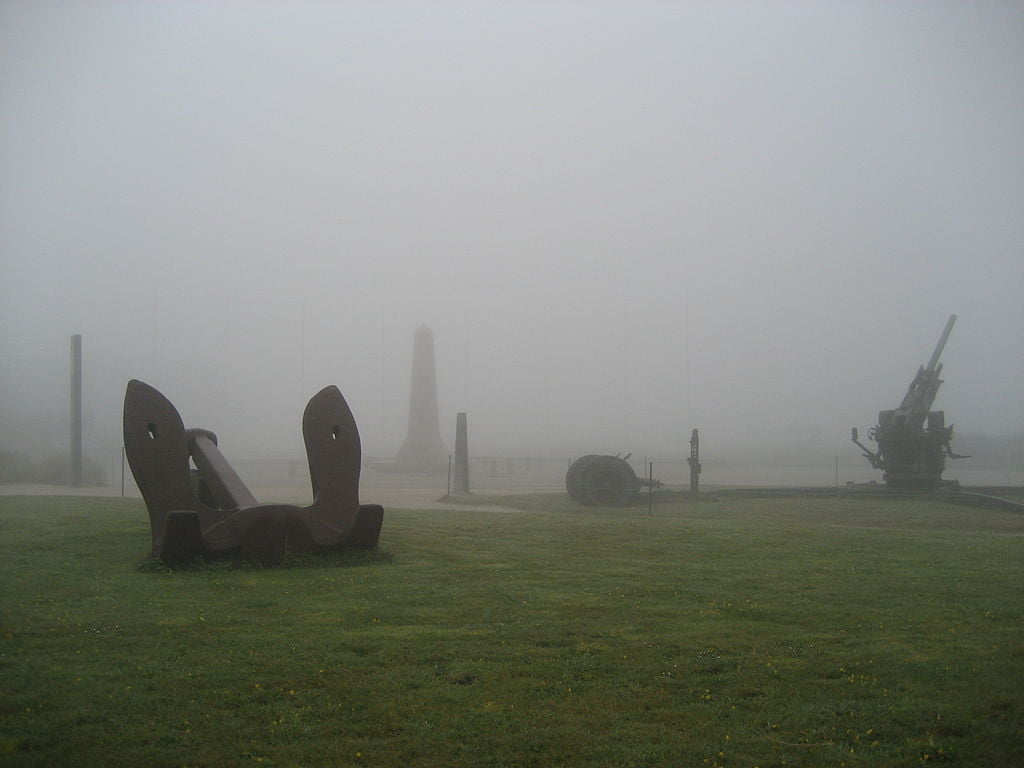
Today, there are several companies that offer various different D-day tours in Normandy, including visits to the cemeteries, landing beaches and/or prominent museums and memorials. Here’s a list including the town from which it starts:
- From Bayeux or Caen: visit the British and American D-day landing beaches and prepare for a moving perspective of this fateful day in history.
- Near Cherbourg: take a guided tour of Utah beach in a WW2 Jeep: with a local guide see the D-day landing beaches in a restored WW2 jeep used by American GIs in 1944.
- From Bayeux: join an American Utah & Omaha Beaches D-day Group Tour
- From Caen: Guided D-day beaches and Caen Memorial tour
- From Le Havre: suitable for cruise ship passengers or anyone staying in and around Le Havre or Honfleur, there is also a D-day landing beaches shore excursion
- From Paris: Small-group Canadian Normandy D-day Tour – walk the shore of the Canadian landing beach, Juno, and visit the Canadian cemetery.
Accommodation in Normandy France
When deciding where to stay when visiting Normandy, it makes sense to be somewhere large enough so that there’s plenty of things to do, places to wander and restaurants to eat at, while also being close to the main areas of interest for you. Because of this, I’d recommend looking for hotels in Bayeux, hotels in Caen, or hotels in Rouen. If you’re coming to Normandy with a car, then you’ll most likely also want hotels with parking too.
For something a little different away from just hotels, you could also check out these Gites in Normandy, or if you’re visiting Normandy with family and you like the camping vibe, but prefer to do it in a little more comfort, then check out Eurocamp as they have a several parks close by, in both Normandy and Brittany.
Is Normandy Worth Visiting: Outro
There are just so many worthwhile things to do in Normandy. From the Bayeux Tapestry to the D-day landing beaches, Normandy is without doubt one of France’s most influential and important regions. It is the birthplace of William the Conqueror (the future King of England), the death place of Joan of Arc (the future Patron Saint of France), it’s where the liberation of western Europe began during the second world war, and it’s a foodie’s heaven. Chuck in its great (and green) transport links from the UK by ferry and Paris by train, as well as its lovely coastline and a liberal smattering of cute seaside ports and harbours, and you’ll wonder why you haven’t been visiting Normandy for years already.
I hope this guide on where to stay and what to do in Normandy has helped you with your planning, and if you’ve got any questions, or even corrections, then please drop a comment below. Until next time, Bon voyage, mes amis!




Leave a reply